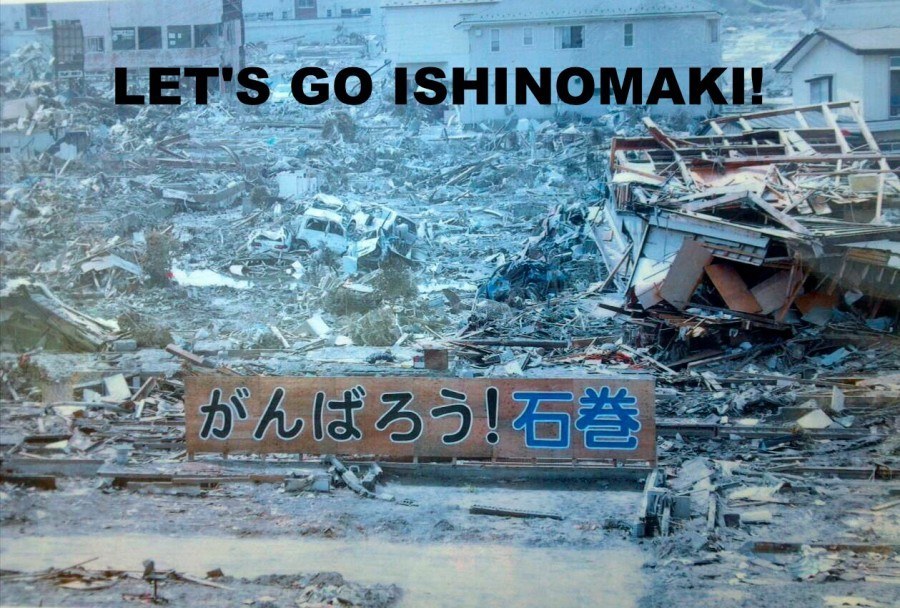Like this post? Help us by sharing it!

With the fourth anniversary of the great tsunami here and the disaster hit areas recently highlighted by Prince Williams royal visit, we thought you might want to read our Steve’s account of his recent Ishinomaki visit…
Recently, I led our A Northern Soul Tour through the wonderful Tohoku region of Japan, following in the footsteps of arguably its greatest poet, Matsuo Basho, who took 6 months of life to hike what became known as Oku No Hosoi Michi, the Narrow Road to the Deep North. The 1200-mile odyssey spawned prolific travel writing and poetry and highlighted this truly wondrous region of Japan.
Although the Japanese themselves are well aware of the region’s many appealing attractions, the (undiscerning) majority of foreign travel companies and travelers overlook it. That was to our advantage recently – it was our own adventure, exclusive in that we met just one Taiwanese group in 2 weeks after leaving Tokyo and heading north!
However, herein lies the sad legacy of the 2011 Great Northeastern Earthquake, which still deeply affects the golden people of Tohoku, both emotionally, economically and in their daily lives. Unfortunately, in an industry where awards are collected like pin badges, somehow validating the quality and trustworthiness of a company, the responsible tourism bandwagon is a crowded bus that every travel firm seems to claim a seat on. Some firms hold, however, suspect credentials.

Therefore, at InsideJapan Tours, we felt it crucial that during a 2 week trip of World Heritage Sites, Nature Trails, zen gardens, sumptuous Japanese feasts and traditional Japanese accommodation with its immaculate service, that we should drop in on one of the afflicted towns of the ensuing tsunami.
Ishinomaki is one such place – a fishing town that, for a while at least, became known to the world. Youtube satiated the voyeuristic lust for the devastating – a disaster unwinding before our very eyes, was satiated as the earth’s assertiveness over humanity was. It was hard-hitting, for some maybe even entertaining, and then it was forgotten. For the people of Ishinomaki, every day touches on that fateful event in some way, for all who survived. 4761 perished, and some 420 people are to this day unaccounted for. The eternal pain and grief that this lack of closure must cause is unimaginable. The sense of loss that this town has had to endure is immense, yet, as perhaps you can imagine, you will not meet a finer community of smiling, warm, welcoming people who can claim to have a clearer perspective on life than someone like myself.
My first visit with the group was a non-scheduled side excursion. We arrived late afternoon so the sun had already set. Although dark, I believe my group understood the reasons to be there. We grabbed 2 taxis and I asked both drivers, who were on duty on that day, to take us where they felt we should see. One driver relayed how he had been parked in the station- front taxi rank at 2:46pm, March 11, 2011, when the huge 8.9 temblor struck off the Tohoku coast. An hour later and the station area, some 3km away from the seafront was inundated with waist high water.

Perhaps the fate of this lucky driver was sealed by falling debris in the station due to the quake. He and other taxi drivers offered comfort and warmth by allowing the injured to sit in the cab until the shaking stopped. He was then involved in helping those (numbers unknown) and so was off duty, away from the coast, and therefore relatively safe.
We were driven to the seafront, peered out into the still darkness which permeated a chillingly menacing presence in the cold darkness. Then onto the famous memorial and logo board, painted just after the disaster. An eternal lantern remains lit, and flowers are regularly laid. The words Ganbarou Ishinomaki (Let’s Go Ishinomaki) are emblazoned upon timber panelling as a motivator and a 6.9metre wave height marker gives context in an area that had 1800 buildings – the majority completely destroyed.
After wracking up 60 pounds in taxi fares, we asked to be dropped in the restaurant area of town. I wanted to put a little money into the pockets of a locally-run business. A little disappointing, yet ironically of course immensely heartening was the fact that I could not find anywhere for my group on a Saturday night – all fully booked. Good to see people are eating out, socializing and enjoying each others’ company – moving on and up. Hence, with the cold and time running out, it was time to leave and head back to the city of Sendai.
For me that encounter was not enough though, and so the week after my tour finished, I made the trip back to the town to spend a day interacting and exploring, in order to put more context to everything. Partly for personal reasons, partly for work, I needed to return to talk to more people, spend a little more money and see the town in the light of day. I rented a cycle and took most of the afflicted areas in.
Next year, I hope to have InsideJapan Tours groups and individual travelers staying in Ishinomaki for a night – the local community will warm to you, you will bring a smile to faces, perspective on life will be gleaned, and hey, if you feel a little good about yourself – well great! Please go to Ishinomaki when you get the chance!
Here are some of the photos that I took on that moving day:














